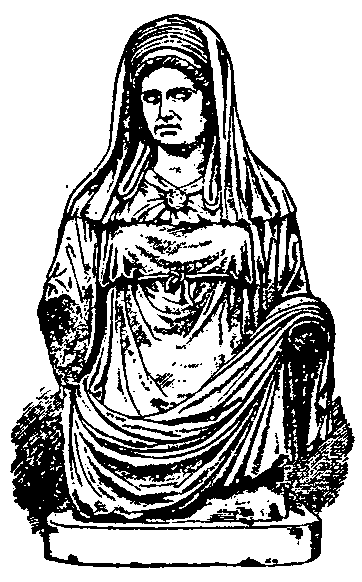|
Dictionary: Search the Dictionary Browse the Dictionary |
|
Timeline: Launch Interactive Timeline |
| Return to Front Page |
| VESTALS | |
| Form: virgines vestales, Vestal Virgins. | |
| The priestesses of Vesta. At Rome their number was at first four, but had already been increased to six during the last years of the kings. Every girl possessing the necessary qualification was liable to be called on to undertake the duty, and no exemption was granted, except upon very strict conditions. The office was confined to girls of not less than six and not more than ten years of age, without personal blemish, of free, respectable families, whose parents were still alive and resident in Italy. The choice was made by lot out of a number of twenty, nominated by the pontifex. The virgin appointed to the priestly office immediately quitted her father's authority and entered that of the goddess. After her inauguration by the pontifex, she was taken into the atrium of Vesta, her future place of abode, was duly attired, and shorn of her hair. The time of service was by law thirty years, ten of which were set apart for learning, ten for performing and ten for teaching the duties. At the end of this time leave was granted to the Vestals to lay aside their priesthood, return into private life, and marry. They seldom took advantage of this permission. They were under the control of the pontifex, who, in the name of the goddess, exercised over them paternal authority. He administered corporal chastisement if they neglected their duties, more particularly if they allowed the sacred fire to go out; and, if any one of them violated her vow of chastity, he had her carried on a bier to the campus sceleratus (the field of transgression), near the Colline Gate, beaten with rods and immured alive. Her seducer was scourged to death. No man was allowed to enter their apartments. Their service consisted in maintaining and keeping pure the eternal fire in the temple of Vesta, watching the sacred shrines, performing the sacrifices, offering the daily and, when necessary, the special prayers for the welfare of the nation, and taking part in the feasts of Vesta, Tellus, and Bona Dea. They were dressed entirely in white, with a coronet-shaped head-band (infula), and ornamented with ribands (vittoe) suspended from it, and at a sacrifice covered with a white veil [called the suffibulum. This was a sort of hood made of a piece of white woollen cloth with a purple border, rectangular in form. It was folded over the head and fastened in front below the throat by a fibula (Festus, p. 340, ed. (Muller, quoted in Middleton's Rome, i 320)]. The chief part in the sacrifices was taken by the eldest, the virgo vestalis maxima. The Vestal Virgins enjoyed various distinctions and privileges. When they went out, they were accompanied by a lictor, to whom even the consul gave place; at public games they had a place of honour; they were under a guardian, and were free to dispose of their property; they gave evidence without the customary oath; they were, on account of their incorruptible character, entrusted with important wills and public treaties; death was the penalty for injuring their person; those whom they escorted were thereby protected from any assault. To meet them by chance saved the criminal who was being led away to punishment; and to them, as to men of distinguished merit, was assigned the honour of burial in the Forum. | |
|
|
|
| Pictures and Media | |
| A VESTAL VIRGIN.(Portrait statne of one of the chief Vestals, of the time of Trajan or Hadrian, showing the sacred vestment called the suffibulum.) |

|
|
Copyright 2000-2020 Peter T. Struck. No portion of this site may be copied or reproduced, electronically or otherwise, without the expressed, written consent of the author. |